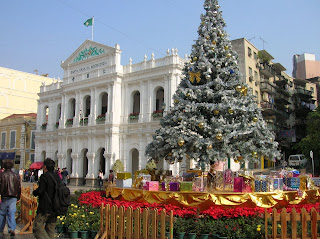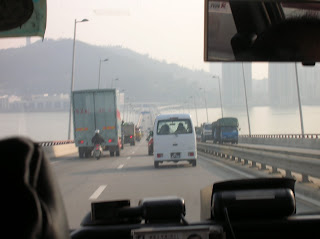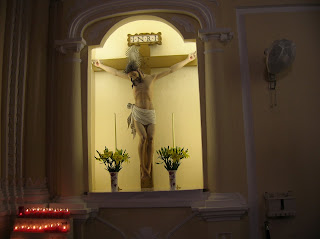Macau is located on China's Southeast coast bordering the Guangdong Province in China. It is about 60 kilometres from Hong Kong. The region is only 28 square kilometres in size and is comprised of the Macau Peninsula and the islands of Taipa and Coloane.
Entering one of the many magnificent bridges of Macau.
As you enter Macau , this would be the first sight of the city.
Located on the Outer Harbour, this statue, dedicated to Goddess of Kun Iam (Goddess of Mercy) is 20 meters tall and made of special bronze. The dome shape base like a lotus flower, is an ecumenical centre where information is available on Buddhism, Taoism and Confucianism.
One of the many Casinos under construction by the waterfront.
Macau Tower , soaring 338 metres above the city, the Macau Tower is the 10th highest freestanding tower in the world and the 8th tallest in Asia.
Crossing point at Senado Square.
St. Dominic's Church
The location of St.Dominic's Church which has been proclaimed as one of the World Heritage List in 2005.
Standing on the site of a chapel and convent built by the Dominicans in the 1590's St. Dominic's dates from the early 17th century.
It has an imposing facade of cream-coloured stone with white stucco mouldings and green-shuttered windows. Inside, white pillars support a flat ceiling and apron balconies trim the walls.
The great baroque altar contains a cream and white statue of the Virgin and Child
and numerous paintings painting of Christ.
The church has a fine collection of exquisitively-carved ivory and wood saints.
To enter the church visitors should ring the bell on the green gate at the side door.
The Lou Kao Mansion was one of the residences of the wealthy Lou Wa Sio family and, according to the date written on a poem on the eaves of the courtyard to the left of the entrance, it was built in the 15th year of the reign of Qing Dynasty emperor Guang Xu (1889).

Visiting Hours..........

Constructed in grey brick, the two-storey xiguan-style building is on of the best-preserved traditional Chinese house in Macao.

Like many other xiguan houses, Lou Kao Mansion has detailed decorations such as brick relief, plaster ornamentation, decorative lattice carvings......


and mother-of-pearl windows, perforated ceilings to facilitate ventilation, iron railings, reflecting a combination of Chinese and Western architecture.
Cathedral Square


The footway that leads to The Cathedral lies a beautiful fountain which shows the magnificient craftmanship that had caught my attention.
The Cathedral
Location : Largo de Se
Senado Square
Location : Largo de Senado

Senado Square a popular tourists spot where boutiques and food outlets are located.

Grand Christmas Tree at the Senado Square , located at the main center square were popular events and celebrations are being held. Behind is the House Of Holy Mercy , established by the first bishop of Macau in 1569.
Casinos
Location : Macau Peninsula

The infamous Lisboa Casino............

The new Lisboa Casino(far left) under construction scheduled for completion March 2007.

Wynn Casino...latest casino in town.

Wynn Casino entrance.

On the way to Airport from mainland Macau.........

Macau International Airport ....Departure and Arrival Hall at Ground Level.

At the Cafeteria after my breakfast cum lunch cum dinner...........

Notice the center picture portuguese's famous eggtart with rasberry....HK$16

Im leavng on a Jetplane, don't know when I be back again..........














































